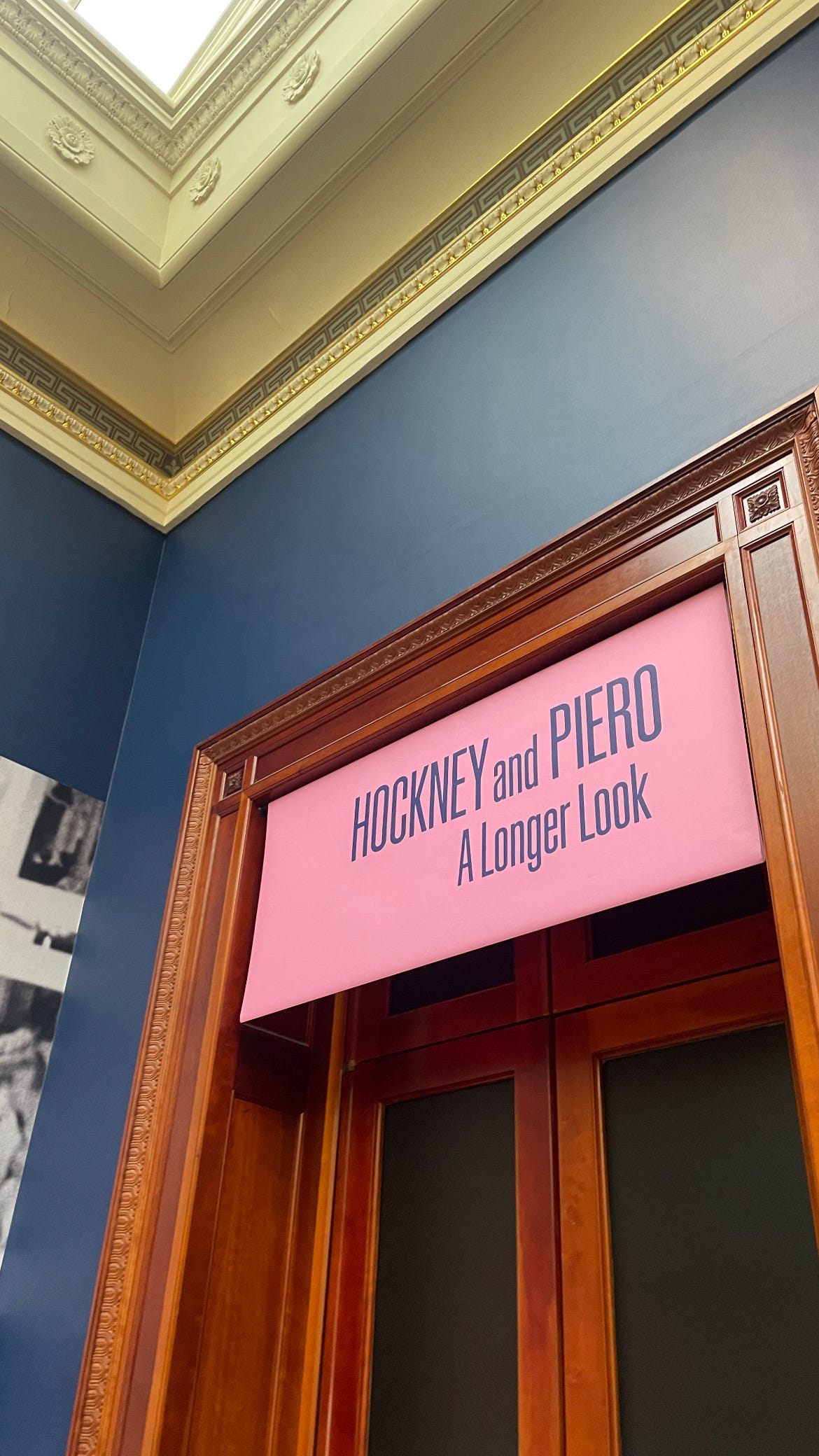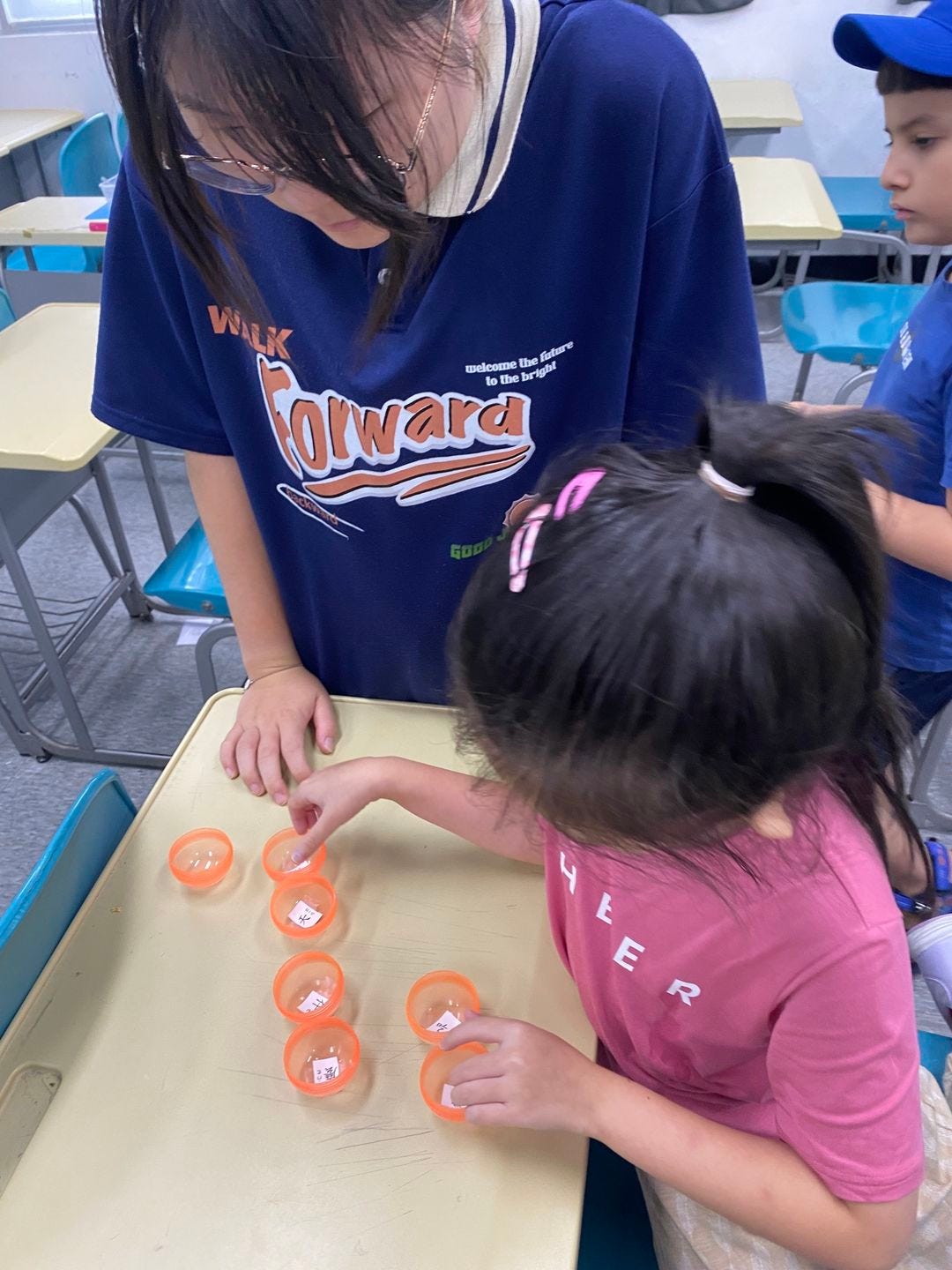My name is Linda. I write a bi-weekly newsletter about computer science, childhood, and culture.
Last week, I spent a long time looking at the National Gallery in London. In room 46, a special exhibition featured two David Hockney paintings paired with Piero della Francesca's The Baptism of Christ. The exhibition's title—and invitation—was to "look longer."
This was the perfect exhibition for me: three works in a small space where I could focus properly. I often find large museums overwhelming and hard to take in. But this was different; it was beautiful. Hockney's modern pieces helped me see the space and time Piero painted almost 600 years ago in a new light. I saw Piero's pearly colors and exact background clearly for the first time and noticed the references in Hockney's work.
Afterward, on my own, I read the accompanying book, Hockney and Piero: A Longer Look, by Susanna Avery-Quash. I learned that the exhibition was a celebration of the National Gallery's 200th anniversary, highlighting how the museum has involved artists in developing and caring for its collection.
However, what stuck with me was how much artists talked about copying the masters. National Gallery had special times for art students to come study the paintings, by copying. In Hockney's words:
"I have come to the conclusion that copying is a marvellous way to learn; it was good enough for Degas, Van Gogh, and almost everybody before 1920. I recommend it to young students of painting now."
Looking at Piero's work alongside Hockney's, I wondered how connected artists are to the art that came before them. The same connection doesn't exist in technology. In technology, we don't read the classics; we rarely go back to code written in the past. Even legacy code—something that might carry a sense of respectability in other fields—is often seen as a burden. Ideas from obscure computer science research papers from the 1980s regularly resurface. History and ideas are cyclical. However, an engineer's education doesn't pay homage to this in the same way that an artist's education does.
Would a similar approach work for the great works of software? Just as artists copy master paintings to understand their techniques, programmers could benefit from studying and rewriting historical code bases. Imagine learning to code by rewriting early Unix kernels, Tim Berners-Lee's original web server, or the Apollo Guidance Computer software.
Piero painted with tempera, an ancient egg-based paint medium. In software terms, this might be like occasionally coding in an old language just for its beauty and expression.
Richard Hamilton recalls his student days during the 1930s:
"As a student at the Royal Academy Schools, I was required to attend the Gallery to make either one full-size copy or three sketch studies each year for the annual examination. I recall the pleasurable hours of deliberation before the intimate act of copying."
When I was learning programming in the mid-2010s, there was a movement around learning-by-typing. For example, Learn Python the Hard Way encouraged students to retype (not copy-paste) code and then explore modifying it. I found this tedious, but I wonder if there was a style, technique, and appreciation that I missed with my impatience. The point of copying is to look longer, pay attention, and slow down. Courses could focus on dissecting, understanding, and re-implementing historical software, treating old code as artifacts worthy of study. Copying could develop skills in reading and understanding code written by others, a skill crucial in real-world software development.
Painter and critic Roger Fry (a founding member of the Society of Painters in Tempera!) stated that "each generation... has to remake its old Masters. If we did not go on continually revaluing and remaking them, they would be not merely old but dead."
The same approach—old, not dead—could benefit coding education.
Hockney and Piero run until October 26. Here are a few past posts on similar topics.
No. 13 — Teaching the history of computers🏺Lineage 👪 History as Wall Art
No. 58 - Science syllabuses with fiction ⫶ The Other Oppenheimer ⫶ Maps of Matter
No. 35 — Archaeological algorithms 🏺 Book club 🍄 Mushroom atlas
Linked List
In computer science, a linked list is a linear collection of data elements whose order is not given by their physical placement in memory. But here it is a selection of things I’ve been reading lately.
Test Your Focus: Can You Spend 10 Minutes With One Painting? An interactive piece by NYT, based on an assignment that Jennifer Roberts, an art history professor at Harvard, gives to her students. She asks them to go to a museum, pick one work of art, and look at only that for three full hours. I love a good worksheet - here is one by professor Roberts for the three-hour looking task.
Metal Gear Solid with Lego. Kojima designing the maps and camera positions with Lego is the little game development history I need.
Zucchini jam with lime, vanilla and ginger by Atelier September. It’s the season.
Classroom
I’m hoping to surface and share stories from all of you and I’d love to see your creations! Here are a few teachers using Ruby in creative, fun and inspiring ways.
My favorite summer camp in Taipei combining Hello Ruby activities creatively. I like the ending: “(…) and it has also successfully let everyone know that computers actually silently help us do a lot of things!”. Here is the activity.









